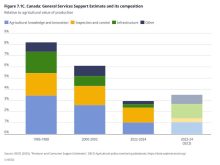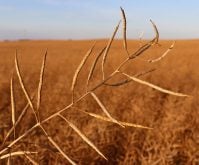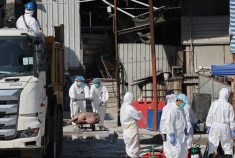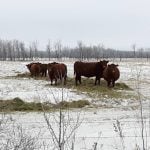Full commitment to a foot-and-mouth disease vaccine bank was one of the top things that came out of July’s meeting of Canada’s federal, provincial and territorial agriculture ministers.
That’s according to Tyler Fulton, a Manitoba farmer and vice-president of the Canadian Cattle Association.
“We kind of knew that it was coming, but more money moving into a strategy that focuses on preparedness and prevention is a good thing,” he said.
Read Also

Beekeepers want financial protection against tropi mite
What happens to beekeepers if the deadly tropi mite reaches Canada? Discover why farmers want robust compensation to protect pollination.
Why it matters: Foreign animal disease is a perennial topic of concern, while long-standing issues like interprovincial trade also got a moment in the spotlight.
The establishment of a FMD vaccine bank was announced in the 2023 federal budget. At that time, the government committed $57.5 million over the next five years to allow the Canadian Food Inspection Agency to establish the bank and develop FMD response plans.
Canada hasn’t had an outbreak since 1952 of the severe, highly communicable disease, which can affect cattle, bison, sheep and pigs. Strict measures are already in place to prevent the virus from entering Canada.
It is also a federally reportable disease, requiring any producers or veterinarians to report any suspected cases.
The World Organization for Animal Health rates Canada as “free from FMD without vaccination,” a classification shared with the rest of North America, Australia and most of Europe, among other regions.
Despite Canada’s distant history with the virus, industry is wary of outbreak, which would affect Canada’s export status with trading partners and create problems for the highly trade-reliant pork and beef sectors.
Globally, the disease has disrupted trade in Botswana and Indonesia in recent years.
Fulton says that, while existing lines of defence are critical, the vaccine bank would mitigate the impact if FMD was ever found here.
“It could be used in order to really shorten the time that we lose our export status,” he said. “That’s really where the benefit lies.
“The hope would be that we’d be able to put in zoning rules and possibly utilize the vaccine to prevent any spread. Once we’ve established the new protocols and zones, it’s possible that the trading partners will open back up to Canadian beef.”
The bank will consist of concentrated FMD vaccines that can be rapidly transformed into usable vaccines in a timely and cost-effective manner.
While funding was already earmarked, ministers at the July meeting discussed the guiding principles, with a focus on supporting sector resiliency and collaborating across sectors.
René Roy, chair of the Canadian Pork Council, said his organization is also pleased with the focus on a FMD vaccine bank.
“This would not be the silver bullet. Prevention is the silver bullet, but it would help us to have a higher level of readiness if it happens,” he said.

African swine fever
Roy said he was also encouraged by the discussions surrounding African swine fever (ASF).
The fatal swine disease spreads through direct and indirect contact with infected pigs, pork and pork byproducts. While not a new threat, and not a threat to humans, alarm arose in 2018 and 2019 following devastating outbreaks in China and other parts of Asia.
During those outbreaks, officials in the U.S. and Canada fast-tracked efforts to prevent ASF infection.
Ministers “are just reinforcing their commitment on this one, but it is really important,” said Roy.
In August 2022, the federal government announced a $24.3 million ASF preparedness program to enhance efforts to prevent the disease from entering Canada and prepare for a potential outbreak.
The July meeting saw ministers acknowledge the need to develop integrated disease prevention, surveillance and management plans. They highlighted the importance of ensuring Canada is ready and has the capacity to respond so public confidence in the meat supply is maintained and market disruptions are minimized.
“We’re crossing our fingers that it does not happen,” said Roy. “It would stop trade. We don’t know for how long at this moment, but it has happened with other industries, such as beef with BSE. So, this kind of situation could happen, and this is why we prepare so much.”
Specified risk material
Ministers discussed negotiations between the Canadian Food Inspection Agency and the cattle sector to better understand the challenges of BSE prevention. They discussed considerations and possible approaches to align with the United States on specified risk material and disposal requirements. SRM, as it is called, is the material in a carcass considered to have high risk of prion contamination, the protein related to BSE infection.
“Canada has a requirement to separate and treat that material differently compared to our American counterparts, and that requires extra handling costs,” Fulton said, noting ongoing discussion about whether the rules are still needed.
“We’re encouraged by the fact that they’re doing the work to effectively analyze the benefits and the costs and answer the question as to whether all this is still necessary, given all of the other measures that have been put in place to prevent the disease,” he said.
Business risk management
Extreme weather situations, including drought and wildfires, brought business risk management to the forefront of the meeting. Program changes resulting from the Sustainable CAP agreement, including shifts to AgriStability, were discussed, and a new AgriStability model will be offered on an optional basis to producers.
“One of the adjustments that they’ve suggested is that they would allow for a different option for reporting AgriStability numbers, and the goal is to make it simpler and more timely,” said Fulton.
“Only time will tell as to whether or not the details will result in a more simple program. But overall, we’re definitely advocates for making changes that make it more accessible, more responsive, more simple, and more timely.”
Livestock Price Insurance also garnered attention at the meeting. The federal government and the Maritime provinces have agreed to continue discussions on a Livestock Price Insurance program for producers in New Brunswick, Nova Scotia and Prince Edward Island.
The program is already in place in Western Canada, while Ontario and Quebec have their own provincial risk management programs.
The cattle sector has been pushing for a national price insurance program. Current ones do not have any premium cost-share with government, unlike crop insurance offered through agencies like the Manitoba Agricultural Services Corporation.
However, Roy said the program is not particularly useful for pork producers.
“We have looked for improvement for this program because the structure is much better for the beef industry,” he said.
Trade
Ministers discussed international trade, market diversification and ongoing trade negotiations. Discussions centred around efforts to position Canada as a trusted and sustainable supplier to the Indo-Pacific region by leveraging Canada’s new Indo-Pacific Agriculture and Agri-Food Office, slated for Manila, Philippines.
While bolstering Canadian trade in Asia is important, Roy said he was disappointed that there was no discussion of the trade imbalance that exists with the U.K. and EU.
“It’s going mainly in one direction,” he said. “We have raised our concern that if we have a free trade agreement, it has to be free and not free for only one of the parties.
“I’m surprised because it was not mentioned,” he added. “We hope that there is a sustained effort to find solutions to these problems.”
Both the cattle and pork industries have expressed disappointment with Canada’s European trade deal, CETA, as well as its post-Brexit deal with the U.K., both of which have seen little Canadian meat bound for those regions due to unaddressed regulatory hurdles.
Province to province
The other trade of interest was closer to home.
Ministers discussed a pilot project in Lloydminster, Sask., aimed at meat processing solutions in rural areas that lack slaughter availability.
The requirement that only meat processed at a federally inspected facility can be traded between provinces has been a thorn in the sides of the livestock and meat sectors.
Ontario, Manitoba and Quebec are assessing the feasibility of conducting their own pilots in remote border areas, where plants are seeking to grow markets through interprovincial trade. As participants are confirmed, individual slaughter availability pilots will be launched.
“It does not have a major impact for our industry, but increased fluidity may help increase market availability for some of our producers and give them access that they did not have before,” said Roy.
















